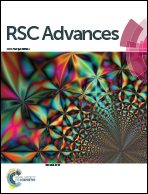Three-dimensional and highly ordered porous carbon–MnO2 composite foam for excellent electromagnetic interference shielding efficiency
Abstract
In this study, high-performance carbon–MnO2 composite foam was developed by using a simple sacrificial template technique from a mixture of MnO2 nanoparticles and phenol formaldehyde resin as a carbon source. It is observed that composite foam possesses density between 0.25–0.35 g cm−3. The addition of MnO2 endows the dielectric and electromagnetic interference (EMI) shielding efficiency with absorption as the dominating constituent in EMI shielding mechanism in X-band frequency region (8.2–12.4 GHz). The obtained carbon–MnO2 composite foam with MnO2 loading of 4 wt% demonstrates excellent specific EMI shielding effectiveness (SE) of −150 dB cm3 g−1. This enhancement is due to the dielectric constant and electromagnetic wave attenuation resulting from the introduction of MnO2. However, the compressive strength of carbon foam improved by 77.3% (7.8 MPa) by the incorporation of 8 wt% MnO2 particles in a carbon matrix. This technique is very fast, highly reproducible, and scalable, which may facilitate the commercialization of such composite foam and it can be used as EMI shielding materials in the fields of aerospace applications.


 Please wait while we load your content...
Please wait while we load your content...